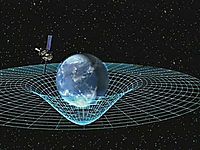
Photo from wikipedia
The present work shows how 4–6-year-old Spanish children interpret numbers and space intervals in the ruler when measuring length. To determine it, 4 ad hoc rulers are designed and used… Click to show full abstract
The present work shows how 4–6-year-old Spanish children interpret numbers and space intervals in the ruler when measuring length. To determine it, 4 ad hoc rulers are designed and used with a sample of 103 children from two schools of Toledo province (Spain). The sample is characterized respecting conservation and measurement with the standard ruler confirming that these children mostly neither conserve nor use the standard ruler correctly, regardless their time exposure to instruction. With the use of our rulers, we confirm that numbers hinder in measuring length, and discrete units imbedded in the ruler help children to measure correctly. A good scaffold is found to help children conceptualize space intervals as iterating objects consisting on the use of rulers with discrete units on them. Its use is recommended preceding the one of standard rulers.
Journal Title: International Journal of Science and Mathematics Education
Year Published: 2018
Link to full text (if available)
Share on Social Media: Sign Up to like & get
recommendations!